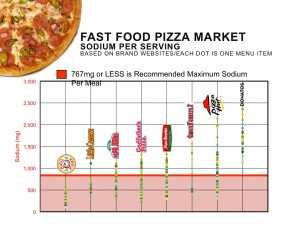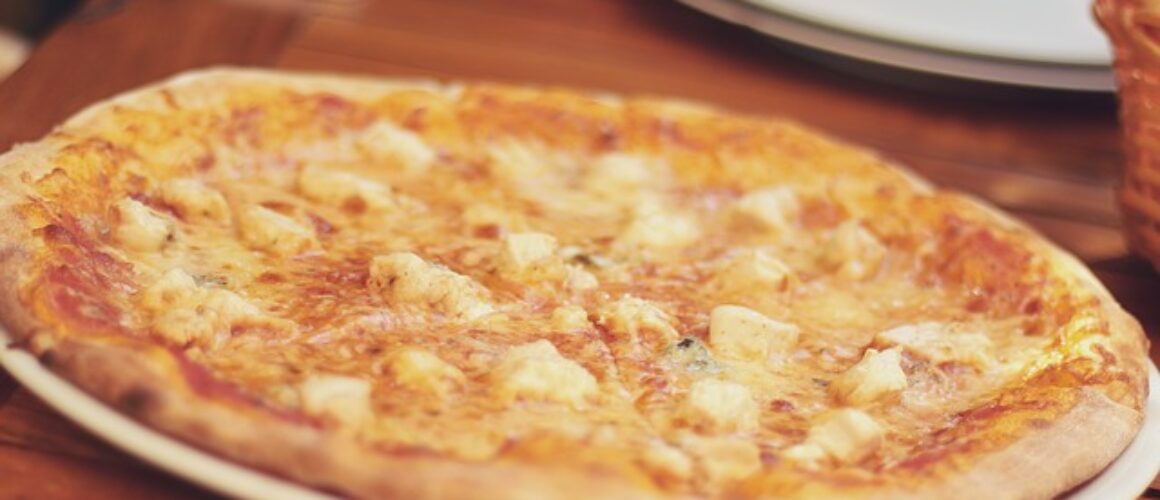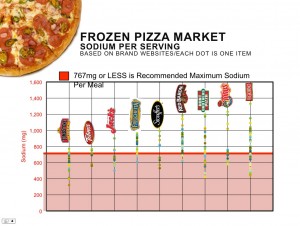Pizza: 9 Things You Need to Know
It’s National Pizza Day. Just a few weeks ago, the Washington Post ran an article on our complete adoration of the stuff.
1. We eat 100 acres a day of pizza.
2. That translates into 3 billion pizzas a year or….
3. 23 pounds of it for every American.
We love the stuff in our house.
But as I dug into that research, I learned something new.
A new study in the journal Pediatrics finds many pre-packaged kids’ meals contain too much salt. We know better now. This isn’t 1984. So what is up?
The researchers looked at the nutrition content of more than 1,000 infant and toddler foods and drinks.
The not-so-good news, 72% of toddler dinners were high in sodium content. The majority of snacks, desserts and juice drinks for both infants and toddlers were found to be heavy on salt.
So why so much salt in our food?
4. Salt is the cheapest ingredient after water
5. Salt holds water, increasing pack weight
6. Salt masks bad flavors from cheap other inputs.

So how much salt are they using and how much do we actually need?
Fact is we all need some sodium… but only about 500-600mg/day ( which is just 1/4 teaspoon of salt), but the actual consumption is 7X times that minimum: 3600 mg/day. In other words, we are getting an entire week’s worth of salt every single day.
The researchers recommend parents and caregivers carefully check labels for sodium and added sugar. They say reducing excessive amounts of these ingredients from birth to 24 months can lead to better health for children now and as they grow.
The health impacts of sodium overconsumption go far beyond high blood pressure. Broad health impact: heart attack, stomach cancer, stroke risk, brain function and dementia, osteoporosis and bone fracture.
I used to think that the toppings would be the biggest sources of sodium in a pizza. I was wrong.
7. 90% of all the sodium in typical pizza comes from the crust and cheese.
8. Crust is usually about 50%
9. Cheese 40%.
It makes sense, it’s a preservative, but does cheese really have to be so jacked up on it? And what can we do?
Increased risk of heart disease and stroke are fairly well-known problems from consuming too much sodium… but I never knew that kids were at risk. Pizza is everywhere, and no one wants to be “that mom” who is constantly saying “no.” There are enough eating issues already.
And as if it couldn’t get any worse for kids, the Chicago Tribune just ran an unbelievable article about kids getting kidney stones because of diets too high in fat and sodium. Some hospitals, like the Children’s Hospital of Pittsburgh at UPENN Medical Center have even created special programs to diagnose and treat it. This used to be something that older people got. Not anymore.
Most kids should only consume 1500-2200 mg of sodium a day, though most are getting well over 3,000. (Source: What we eat in America, National Health and Nutrition Examination Survey, 2009-10, Pediatrics).
I looked at a few of the leading pizza companies out there, like Pizza Hut, Papa Johns, Dominos, and almost all of them had much more sodium in a typical 2-slice meal that maximum recommended by the CDC on a per meal basis (some 2-slices of pizza had more sodium that a child/adolescent or adult should have in a whole day!). Many frozen pizzas and the pizza our kids eat in school that I found data on also has a lot of sodium.
Where does all this lead?
As of 2013, one in six kids age 8-17 has high blood pressure, up from one in twenty just 11 years ago. (Source: Sodium Intake and Blood Pressure Among U.S. Children and Adolescents, Journal Pediatrics, September 17, 2012).
So what can we do? Pizza is everywhere.
I am a big fan of better food. But we also love pizza.
I appreciate the value of innovation and technology to make food we eat healthier. But how are we supposed to do better, if we don’t know any better? Food companies have to come clean. There has never been a better opportunity than now.
A quick look at this chart shows you who the big offenders are in the frozen and fast food categories. Choose wisely if you are eating these brands, or make your own with english muffins, spaghetti sauce and some grated cheese.
We can solve this.
I have been at many industry events and trade shows, seen and tasted some great alternatives to regular salt and the high sodium it contains. Solutions exist so that our food taste great but without doing us harm.
What can you do to take care of your kids? Read labels on packages, ask for nutritional information when you eat out and ‘vote’ with your purchases… for healthier food. Importantly let the management of Domino’s, Pizza Hut, and even Costco know… that you want them to please hold the salt. They are listening. Our kids may only represent 30% of the population, but they are 100% of our future.
#rethinkfood
Sources:
http://www.cdc.gov/salt/pdfs/children_sodium.pdf

